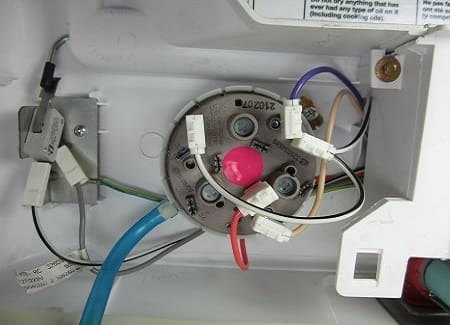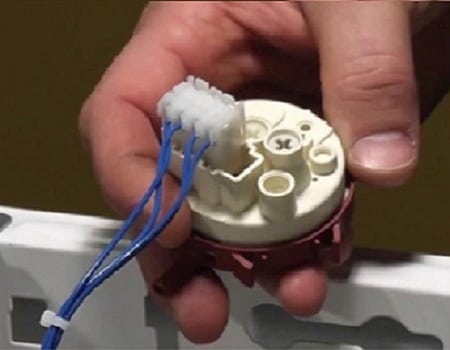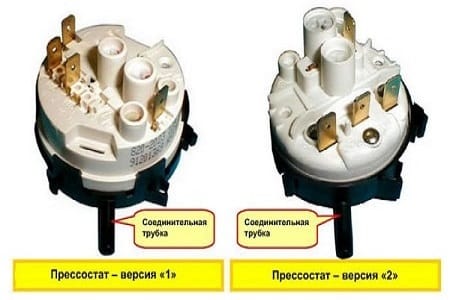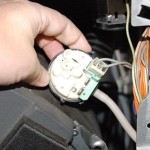How to check the pressure switch of the washing machine, if there is no extra money to call the master? If the warranty on the washing machine has expired, then you can do it yourself. However, before checking the pressure switch of the washing machine, you need to know where it is, what it is and understand the principle of operation of the water level sensor.
The principle of operation of the pressostat
Each washing machine is equipped with a water level sensor (pressure switch). It serves to supply an electric signal to the controller of the washing machine about the presence or absence of water in the tank to perform further operations according to the established washing program.
A standard pressure switch consists of a disk-shaped sealed enclosure, inside which an air chamber is located. A tube is connected to it through the fitting, lowered by the second end into the tank of the machine. When water enters the machine, the air pressure in the tube and pressure chamber increases. The sensitive membrane begins to lift the stem, which presses on the spring-loaded contact plate.

Upon reaching a certain level of fluid in the tank, the spring plate clicks to the upper position, closing the electrical circuit of the sensor input lamellas. If the contents of the tank merge, then the pressure in the chamber decreases, the rod goes down and the contact plate switches to the lower position, breaking the electrical circuit. By the signal of the pressostat, the controller gives control signals to other actuators (pump, pump, engine, intake valve, heater relay).
![]() See also - What to do if the washing machine does not open after washing?
See also - What to do if the washing machine does not open after washing?
Symptoms of a water level sensor malfunction
Failure or malfunction of the pressostat leads to malfunctions of the washing machine. Externally, the signs of a malfunction of the water level switch may look like this:
- the machine erases or turns on the heater when there is no water in it;
- the tank is filled with water or vice versa, it is clearly not enough for washing;
- when the rinse mode is activated, periodic pumping out and fluid supply occurs;
- the appearance of a burning smell and the fuse of the heater;
- the laundry is not spinning.

The appearance of such signs should be an occasion in order to check the operation of the pressure switch, for which you need to arm yourself with a screwdriver with interchangeable nozzles, since many manufacturers use fasteners with special heads for protection against unauthorized access.
![]() See also - The drum does not spin in the washing machine
See also - The drum does not spin in the washing machine
How to check the pressure switch yourself
The above deviations in the operation of the washing machine may be the result of malfunctions and other details, so you need to check the operation of the pressostat before putting a new one. To do this, it should be removed from the machine. Where is the water level sensor in the washing machine? In order to find and check the pressure switch, you must perform the following steps:
- having unscrewed two bolts from the back of the washing machine, remove the top cover of the machine with a shift back;
- on the side wall find the pressostat fixed with screws, disconnect the connector with wires from it and the hose connected to the fitting with a clamp;
- unscrew the fixing bolts and dismantle the unit.

Carefully inspect it and the tube for external damage or blockage. If necessary, clean the tube and fitting. The external lamellas on the connector must be clean without signs of oxidation. If dirt and corrosion are present, clean them. The performance check must be carried out in the following order:
- Put a small hose on the fitting and, holding the unit to your ear, blow it into the hose. When the sensor contact is triggered, a clear click should be heard.
- Depending on the design of the unit and the number of contact groups, the number of clicks when blowing the hose can be one, two or three. The absence of clicks indicates a malfunction of the device.
- You can verify the reliability of the operation of the contacts using an ohmmeter, connecting it to the corresponding sockets on the input connector of the unit. With the closing and opening of the contacts, the readings of the device will change dramatically. The wiring diagram for the contact groups of the pressure switch can be found in the operating instructions for the washing machine.
![]() See also - The washing machine does not drain the water - what should I do?
See also - The washing machine does not drain the water - what should I do?
Setting the water level sensor
Setting the pressure switch to the desired amount of fluid is done using two adjustment screws, one of which (central) serves to set the moment of connection of the contacts, and the second (peripheral) is used to set the moment of their break. There may be several contact groups or sensors depending on the operating modes and model of the washing machine. Programs of different washing modes can also use different amounts of liquid in the washing machine, for example, economical or gentle washing, in which the tank is filled halfway.
Fine adjustment of the signaling device is carried out by specialists at the factory, and the position of the adjusting screws is fixed with paint or varnish. Changing their position is not recommended, as unbalancing the settings will cause disturbances in the debugged washing program. In order to properly configure the unit yourself, you need to know how much fluid the machine needs at each stage of all washing modes, and in accordance with this set the moments of contact groups on and off. For example, the pressure switch of a Bosch washing machine has three contact groups configured for full mode, economy mode and overflow of the tank.
![]() See also - The washing machine jumps during the spin cycle.
See also - The washing machine jumps during the spin cycle.
Pressostat replacement procedure
After making sure that the water level sensor is malfunctioning, you can change it to a new instance. In the event of a malfunction of the pressure switch, you can perform DIY washing machine repair. Repairing the water level sensor does not make sense, since its body is not separable and attempts to disassemble it will lead to breakdown of internal parts. The new water level sensor must be exactly the same type and name as the old one, corresponding to this brand and model of the machine, taking into account the capacity of the loading drum. It also does not hurt to check before installation. Installation of the unit is carried out in the reverse order of dismantling:
- fastening in place with fixing screws;
- connecting the hose to the fitting and tightening the clamp;
- connecting wiring with a connector;
- installation of the top cover and tightening of the fixing bolts.
After you finish the repair, you should turn on the washing machine and check the operation in several modes or perform a control wash.
![]() See also - TOP 10 front-loading washing machines - ranking of the best 2017
See also - TOP 10 front-loading washing machines - ranking of the best 2017


If the presostat is analog (electronic), then you will not hear clicks when purging it; it is much more difficult to check such a presost.
So which screws to twist?
SMA HAIER HW50-12866ME electronic pressure switch does not fill in water and electromagnetic unlock opens the hatch door this does not happen when the pressostat is opened, water does not fill in, but unlock does not open the door closed with a click ...